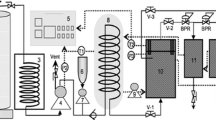Abstract
Soy protein isolate (SPI) is a widely used food ingredient and is made by extracting soy flour (SF) under slightly alkaline pH, followed by precipitation, washing, and drying. Soy foods and foods containing soy protein ingredients have great potential in the prevention of cardiovascular diseases and cancers. These health benefits have been attributed to isoflavones in soy protein ingredients. However, the current processing techniques were developed many years ago without this knowledge. The objective of this study was to investigate the mass balance of different isoflavones during manufacturing of SPI and to provide basic information to assist further development efforts leading to preservation of soy isoflavones in soy protein ingredients. The study revealed that only about 26% of the total isoflavones in SF remained in SPI. The percentages of total isoflavones lost during extraction, precipitation, and washing were 19, 14, and 22%, respectively. Washing was the step where most isoflavones were lost. The isoflavone profile of the SPI was different from that of SF. The former contained much more aglucones (genistein and daidzein), while the latter had almost none. The high content of aglucones in SPI was probably due to the hydrolysis of glycosides.
Similar content being viewed by others
References
Carrol, K.K., Review of Clinical Studies on Cholesterol-Lowering Response to Soy Protein, J. Am. Diet. Assoc. 91:820–827 (1991).
Slavin, J., Nutritional Benefits of Soy Fiber, Ibid.:816–819 (1991).
Jacues, H., D. Laurin, S. Moorjani, F.H. Steinke, C. Gagne, D. Brun, and P.J. Lupien, Influence of Diets Containing Cow’s or Soy Protein Beverage on Plasma Lipid in Children with Familial Hypercholesterolemia, J. Am. Coll. Nutr. 11:69S-73S (1992).
Adlercreutz, H., H. Honjo, A. Higashi, T. Fotsis, E. Hamalainen, T. Hasegawa, and H. Okada, Urinary Excretion of Lignans and Isoflavonoid Phytoestrogens in Japanese Men and Women Consuming a Traditional Japanese Diet, Am. J. Clin. Nutr. 54:1093–1100 (1991).
Lee, H.P., L. Gourley, S.W. Duffy, J. Esteve, J. Lee, and N.E. Day, Dietary Effects on Breast-Cancer Risk in Singapore, Lancet 337:1197–1200 (1991).
Wang, H.J., and P.A. Murphy, Isoflavone Content of Commercial Soybean Foods, J. Agric. Food Chem 42:1666–1673 (1994).
Messina, M.J., V. Persky, K.D.R. Setchell, and S. Barnes, Soy Intake and Cancer Risk: A Review of the In Vitro and In Vivo Data, Nutr. Cancer 21:113 (1994).
Eldridge, A.C., and W.F. Kwolek, Soybeans Isoflavones: Effect of Environment and Variety on Composition, J. Agric. Food Chem. 31:394–396 (1983).
Anderson, R.L., and W. Wolf, Compositional Changes in Trypsin Inhibitors, Phytic Acid, Saponins and Isoflavones Related to Soybean Processing, J. Nutr. 125:581S-588S (1995).
Barnes, S., and M. Messina, Soy and Its Role in Cancer Prevention, The Soy Connection. 1:1–3 (1993).
Smith, A.K., and S.J. Circle, in Soybeans: Chemistry and Technology, edited by A.K. Smith and S.J. Circle, AVI Publishing Co., Westport, 1976, p. 339.
Eldridge, A.C., Determination of Isoflavones in Soybean Flours, Protein Concentrates, and Isolates, J. Agric. Food Chem. 30:353 (1982).
Wang, H.J., and P.A. Murphy, Isoflavone Composition of American and Japanese Soybeans in Iowa: Effects of Variety, Crop Year, and Location, J. Agric. Food Chem 42:1674–1677 (1994).
Author information
Authors and Affiliations
Corresponding author
About this article
Cite this article
Wang, C., Ma, Q., Pagadala, S. et al. Changes of isoflavones during processing of soy protein isolates. J Amer Oil Chem Soc 75, 337–341 (1998). https://doi.org/10.1007/s11746-998-0050-7
Received:
Accepted:
Issue Date:
DOI: https://doi.org/10.1007/s11746-998-0050-7




